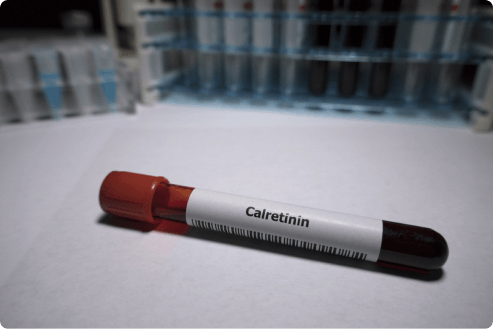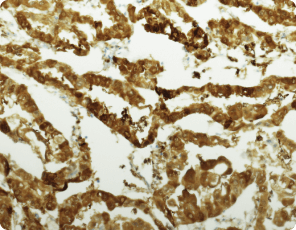Calretinin
Calretinin is a protein normally found in the body. It binds to calcium to send signals controlling processes such as cell growth. When found in large amounts, it can be a marker of diseases like mesothelioma. Studies find calretinin in more than 95% of epithelioid and biphasic mesothelioma cases.

What Is Calretinin?

Calretinin is a protein that plays a role in important cell processes in your body. It attaches to calcium ions, which send signals to control a wide range of different functions from muscle contractions to cell growth.
High calretinin levels don’t cause cancer, but they can be a sign or marker of cancer, particularly mesothelioma. It can help pathologists in the diagnostic process. Finding calretinin can help pathologists tell mesothelioma cells from other types of cancer.
This biomarker can particularly help diagnose the epithelioid mesothelioma subtype. This is the most common and treatable subtype.
Studies show that calretinin can identify mesothelioma with up to 90% accuracy in epithelioid cases. However, it’s only 55% accurate in sarcomatoid mesothelioma cases, so additional markers are needed for a confirmed diagnosis.
Using Calretinin to Diagnose Mesothelioma
Immunohistochemistry tests tissue samples for cancer markers such as calretinin. Finding calretinin can help pathologists confirm a mesothelioma diagnosis. This step is critical for differentiating mesothelioma from similar cancers.
How Calretinin Helps Diagnose Mesothelioma
- Calretinin positive: Indicates the presence of mesothelioma cells.
- Diagnostic accuracy: Up to 90% for epithelioid mesothelioma and 55% for sarcomatoid cases.
- Marker combinations: When other markers are found including mesothelin, WT1 and podoplanin for improved accuracy.
Combining calretinin with mesothelin increases diagnostic sensitivity and reduces the risk of misdiagnosis. Finding calretinin alone may not always detect sarcomatoid mesothelioma, highlighting the need for multiple markers.
Differentiating Mesothelioma from Other Cancers
Calretinin’s specificity makes it very helpful in being able to tell mesothelioma from other cancers, for example, adenocarcinoma. High levels of calretinin can be found in mesothelioma samples, but aren’t typically found in adenocarcinoma samples.
Mesothelioma develops on the mesothelium or thin membrane that lines the chest cavity and covers the lungs. Adenocarcinoma develops in the glands in the lungs. It accounts for about 40% of all non-mall cell lung cancer diagnoses, the most common type of lung cancer.
- Adenocarcinoma: Lacks calretinin expression but may show other markers like TTF-1.
- Mesothelioma: Positive for calretinin and WT1.
A 2022 study in the World Journal of Surgical Oncology did report the possibility of misdiagnosis from relying on finding calretinin alone. It found doctors could mistakenly use calretinin positivity to misdiagnose mesothelioma instead of desmoid fibromatosis.
This underscores the importance of looking at calretinin in combination with other key markers. This can help ensure mesothelioma is accurately identified, even in complex cases.
“Calretinin helps the pathologist distinguish between epithelial mesothelioma and adenocarcinoma. This reduces the chances of misdiagnosis.”
Calretinin vs. Other Biomarkers
Using calretinin to diagnose mesothelioma works best when also looking for other biomarkers. This approach improves diagnostic precision and reduces errors. Looking for other IHC markers can especially help pathologists better identify sarcomatoid mesothelioma and confirm asbestos-exposure-related cancers.
Complementary Biomarkers
- Mesothelin: Commonly used with calretinin to confirm mesothelioma.
- Podoplanin: Also called D2-40, this protein is useful for identifying pleural mesothelioma.
- WT1 protein: Highly specific for mesothelioma, especially in pleural cases.
A 2000 study in the journal Cancer found calretinin was positive in all but 2 mesothelioma cases. The researchers noted it’s a valuable marker in differentiating mesothelioma of the epithelial type from adenocarcinoma in fluid buildups known as serous effusions.

Understand your diagnosis, top doctors and ways to afford care.
Get Your Free GuideCalretinin as a Potential Target for Mesothelioma Treatment
Doctors are studying calretinin to see if it can be used to treat mesothelioma, not just diagnose it. Research shows it may affect how tumors grow and respond to treatments, which could lead to new ways to fight this cancer.
Key Calretinin Research
- Biomarkers for recurrence: Doctors are studying proteins called MALAT1 and GAS5 to see if they can help predict if mesothelioma will come back after treatment.
- CALB2 gene: The CALB2 gene makes calretinin, and doctors are exploring if it could be used in gene therapy to treat mesothelioma.
- Clinical trials: Ongoing studies are investigating new ways to target or block calretinin to try to slow tumor growth or make existing therapies like chemo work better for patients.
Because research shows calretinin plays a key role in mesothelioma cell growth and survival, blocking this protein could possibly slow or even stop tumors from progressing. High levels of calretinin have been linked with the aggressive spread of mesothelioma, so there’s significant interest in being able to target it.
High levels of calretinin in the blood are linked to faster cancer growth and shorter survival in mesothelioma patients getting chemo. This means it could help predict how well treatment will work.
Common Questions About Calretinin
- What does calretinin-positive indicate?
-
Calretinin-positive results confirm the presence of mesothelioma cells. This provides crucial evidence to pathologists trying to differentiate mesothelioma from other cancers. This specificity is especially vital in cases where symptoms and imaging studies alone can’t provide a definitive diagnosis.
- What makes calretinin a reliable biomarker for mesothelioma?
-
Calretinin is considered a highly reliable sign or marker of mesothelioma because of its strong association with epithelioid mesothelioma. Its detection accuracy of up to 90% in epithelioid cases makes it an important tool for pathologists. When pathologists look for other markers, especially with other subtypes of mesothelioma, it can help avoid misdiagnosis.
- Can calretinin be used in the early diagnosis of mesothelioma?
-
Tissue samples that look for calretinin are usually taken after the onset of symptoms. Ongoing research is exploring its potential role in identifying early-stage mesothelioma. The earlier a patient is diagnosed, the sooner treatment can begin, which could lead to improved outcomes for patients.
- How does calretinin compare to other biomarkers?
-
When pathologists look for calretinin and other biomarkers such as mesothelin and WT1, it creates a more comprehensive diagnostic picture. This can increase the accuracy of the diagnosis. Some biomarkers are less reliable than calretinin, but this protein’s strong correlation with this disease makes it a cornerstone of diagnostic testing.




